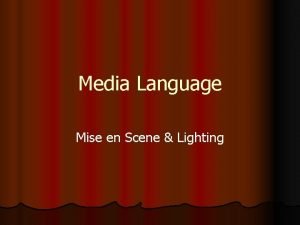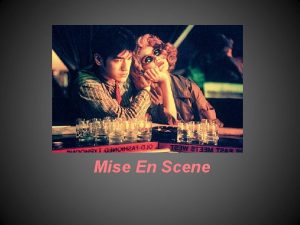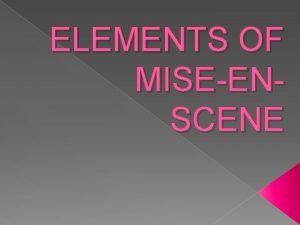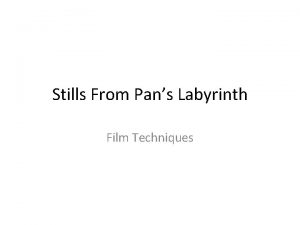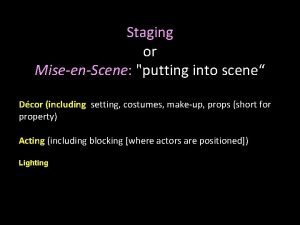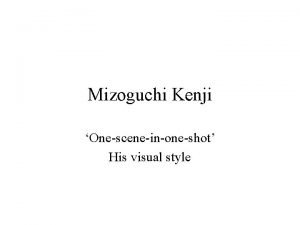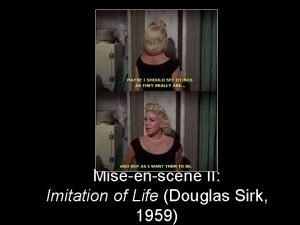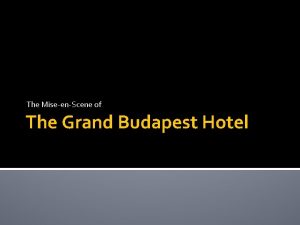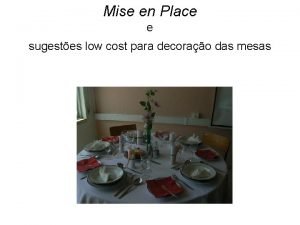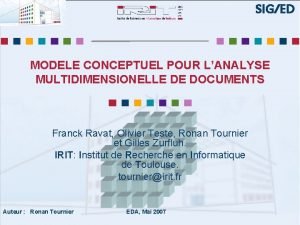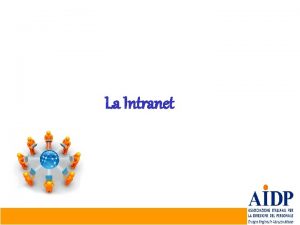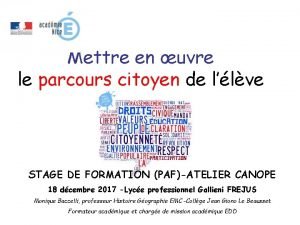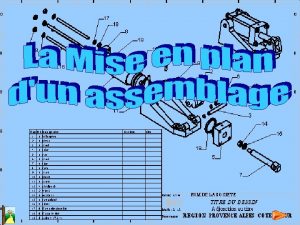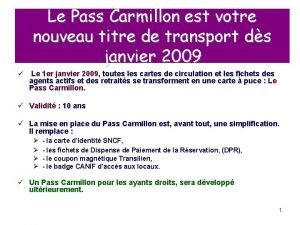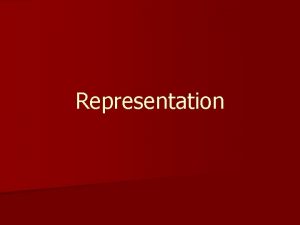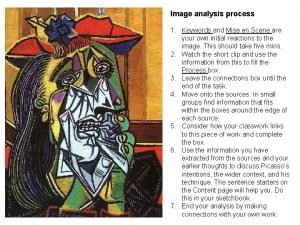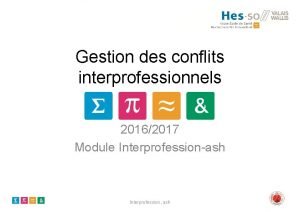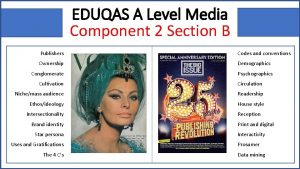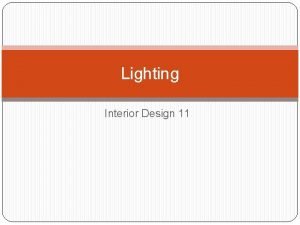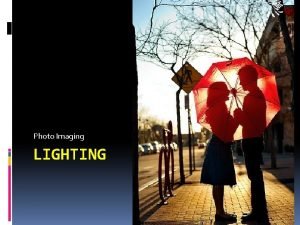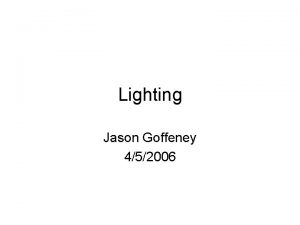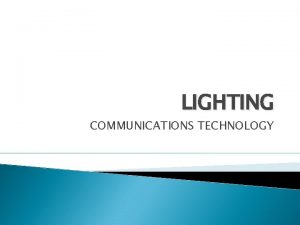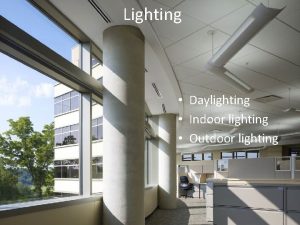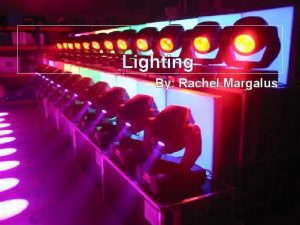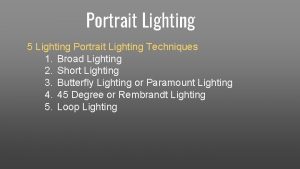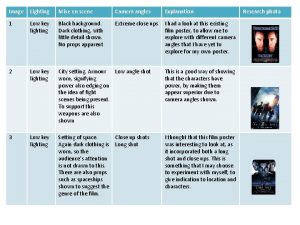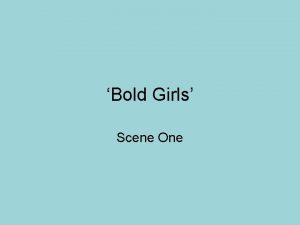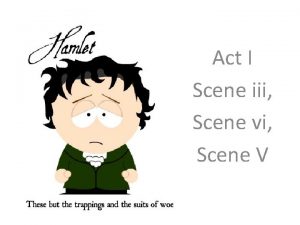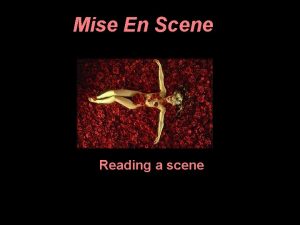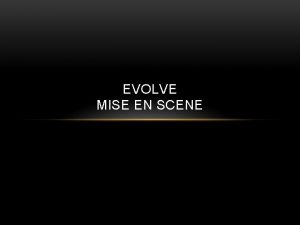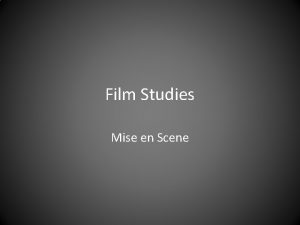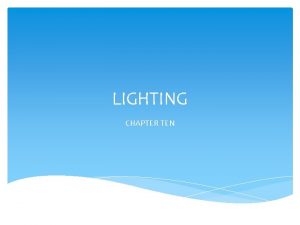Media Language Mise en Scene Lighting What you






















- Slides: 22

Media Language Mise en Scene & Lighting

What you need to know l Mise-en-Scène l Production design: location, studio, set design l Costume and make-up, properties. l Lighting; colour design.

What is Mise en scene? Originally a theatre term that is now used in Film Studies meaning ‘staging’ it crossed over to signify the film production practices involved in the framing of shots. l “Mise-en-scene may be described as the expressive tool at the filmmaker’s disposal which a critic can read to determine the specificity of the cinematographic work. ” (Hayward, S, 1996) l Critics can identify the particular style of a specific filmmaker and thereby point to it as an ‘authorial’ style. l

l We can also distinguish genre and subgenre through the use of iconography. l Use of mise-en-scene is often very symbolic and may infer several meanings to the audience about a given situation, character or location. l When we study a text’s mise-en-scene we are concerned with everything within the frame!

What constitutes the Mise-en-scene? l The setting – location where the action takes place. It may be artificially constructed (studio sets) or ‘shot on location’. Certain genres are associated with certain settings. Eg. Soap Operas in domestic settings such as homes or social settings such as pubs or cafes.

Activity sheet-State what settings you would expect to find in each of the TV Drama subgenres. l Teen, medical, crime, historical, legal and soap l Consider why these settings are typically used. - What function do they serve in the narrative? -What do they tell us about the characters in terms of class, race, gender, age & regional identity? l

Costume l Clothing, accessories, prosthetics etc. (Colour, style, authenticity etc. ) Costume often signifies more about a character’s life or personality than we may be actually told through dialogue.

For example, consider a character like Clark Kent in the American TV Drama, Smallville. Always in red, white and blue – patriotic, fresh-faced ‘All. American boy’ here to save the world! l However, when affected by black kryptonite, he becomes a ‘baddie’ and his costume expresses this! l

Activity l Watch the extract from Pride & Prejudice. (BBC, 1995) Consider the use of costume in the extract – what does it suggest about the characters’ personalities or attitudes that is not expressed through the dialogue? l Why did the director choose to use costume in this way? l l http: //www. youtube. com/watch? v=CQSFmrk. R-QA&feature=related

Colour Palette l Connotations of use of colour within the frame. Whilst most British TV Dramas operate within realism and favour a more naturalistic look, some are extravagant with colour. Sci-fi texts often use bright colour palettes since they are not bound by the constraints of realism. However, some use colour to signify further plot information.

Activity Watch the extract from Casanova. Consider the purpose of the colour palette. - What does it tell us about character? - What does it add to the representation of gender, sexuality, class & race? - What does it tell us about the narrative at this stage of the drama? - http: //www. youtube. com/watch? v =nq-Zt. Zx. KBm. I

Characters and Character Movement l The way a character walks, their body language, gestures, facial expressions etc all create different connotations for the viewer and are vital in supplying plot information for the viewer.

Activity l l l Watch the extract from Bleak House. Focussing on the characters – the way they move, their body language, gestures and facial expressions – consider what assumptions we can make about their personalities, agendas and roles in the narrative. Use the worksheet to make detailed notes on each. How do costumes, setting, colour and lighting further this image? http: //www. youtube. com/watch? v=q 9 G 4 It. H 2 T-w

Lighting Generally, the way a scene is lit will impact upon the overall visual style of the text. In film, certain directors may use lighting as part of their own unique visual style and may make their work recognisable. Think of Tim Burton and Sleepy hollow and when the horseman attacks. l In TV, however, lighting is often limited to naturalistic lighting due to the desire to achieve a sense of realism. Occasionally though, even TV producers can get creative! l

Lighting Terminology l Three point lighting – This is standard lighting in mainstream film/TV. Used in classical Hollywood cinema. There are three lights: key, fill and back. The balance can be altered to create different effects.

l High-key lighting/Soft lighting – Here there is key light is brighter than the fill light. As a result, the subject being lit appears brighter and softer. Eg. Old Hollywood films where the heroine appeared to have a bright, light face.

l Low-key lighting/ Hard lighting – Here the key light is weaker than the fill. The result is harsh shadows on the subject. This technique is most commonly associated with film noir, gangster or horror genres.

l Back lighting – Most commonly associated with horror films. The subject is lit only from the back, creating a silhouette effect. The features of the subject are not visible and may, therefore, appear more menacing.

l Side lighting – This highlights the subject and distorts the image, making it feel imbalanced.

l Frontal Lighting – This flattens the image and removes the illusion of three dimensionality.

l l Chiaroscuro Lighting – This type of lighting is most commonly associated with film noir. It may be defined as an extreme contrast between light and dark. White and black contrast harshly and establish questions around identity of the character and a separation between the blanc and noir worlds. http: //www. youtube. com/watch? v=4 vur 81 WC 2 Gw

Activity the extract from The Hogfather. l Identify the types of lighting in use in the three scenes. l Why has the director chosen each type of lighting? What does it add to the mood of the scene? l What does it add to our understanding of the narrative at this stage of the drama? l View l http: //www. youtube. com/watch? v=CNT 7 BZXYM 7 o
 Mise en scene lighting
Mise en scene lighting Definition of mise en scene
Definition of mise en scene Elements of mise-en-scene
Elements of mise-en-scene Pan's labyrinth mise en scene
Pan's labyrinth mise en scene Mise en scene staging
Mise en scene staging Deep space composition
Deep space composition Mise en scene
Mise en scene Mise en scene grand budapest hotel
Mise en scene grand budapest hotel Objectives of canape
Objectives of canape Opening bar checklist
Opening bar checklist Mise en place completa
Mise en place completa Multidimensionelle
Multidimensionelle Intranet mise lavoro agile
Intranet mise lavoro agile Need a service chapter 5
Need a service chapter 5 Parcours citoyen exemple
Parcours citoyen exemple Plan assemblage
Plan assemblage Pass carmillon rer
Pass carmillon rer Mise en abyme
Mise en abyme Jerolim mise
Jerolim mise Batardeau
Batardeau Mise en image
Mise en image Mise en contexte exemple
Mise en contexte exemple A level media vogue
A level media vogue
